Search the Special Collections and Archives Portal
Search Results
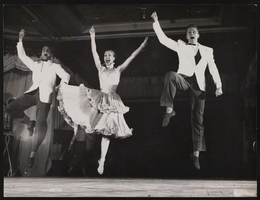
Photographs of Donn Arden's productions at the Lido, Paris (FRA), 1950s-1960s
Date
Archival Collection
Description
Image

Two signs in the desert: photographic slide
Date
Archival Collection
Description
From the Sister Klaryta Antoszewska Photograph Collection (PH-00352). Sign on the left reads: "NOTICE vehicles transporting explosives STOP 1000 ft. ahead use telephone for instructions". Sign on the right reads: "Unauthorized explosives prohibited on the Nevada Test Site".
Image
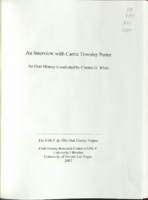
Transcript of interview with Carrie Townley Porter by Claytee D. White, February 7, 2006
Date
Archival Collection
Description
Text

Photographs of Frontier Strike: Jesse Jackson, Culinary Union, Las Vegas (Nev.), 1992 April 21 (folder 1 of 13)
Date
Archival Collection
Description
Frontier Strike participants march near the Hilton Hotel and Casino and the Las Vegas Convention Center. Strikers are holding banners, signs, and multiple flags, including the American flag. Banners reading "Conquering the Frontier, Culinary Local 226, Bartenders Local 165" and "Service Employees International Union, AFL-CIO, CLC" are prominently displayed. On site are former secretary-treasurer of the Culinary Workers Union, Jim Arnold, and American civil rights activist, Jesse Jackson. Arrangement note: Series I. Demonstrations, Subseries I.A. Frontier Strike. Site name: The Strip (Las Vegas, Nev.)
Image
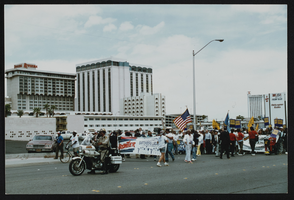
Photographs of Frontier Strike: Jesse Jackson, Culinary Union, Las Vegas (Nev.), 1992 April 21 (folder 2 of 13)
Date
Archival Collection
Description
Frontier Strike participants march on the Las Vegas Strip near the Riviera, Hilton, Stardust, and Frontier. Strikers are holding banners, protest signs, and multiple flags, including the American flag. Banners reading "Conquering the Frontier, Culinary Local 226, Bartenders Local 165" and "Service Employees International Union, AFL-CIO, CLC" are prominently displayed. On site is former secretary-treasurer of the Culinary Workers Union, Jim Arnold, and American civil rights activist, Jesse Jackson. Arrangement note: Series I. Demonstrations, Subseries I.A. Frontier Strike. Site name: The Strip (Las Vegas, Nev.)
Image
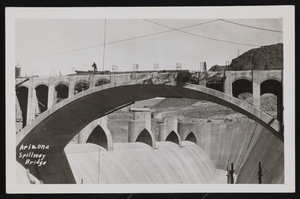
Postcard of spillway construction, Hoover Dam, 1934-1952
Date
Archival Collection
Description
Image
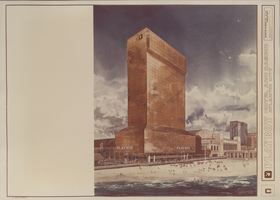
Proposal for the Playboy Hotel and Casino, Atlantic City, 1977
Date
Archival Collection
Description
Bound proposal for Playboy Hotel and Casino including artist's conceptions, vicinity map, themes, and architectural drawings for all major components. Includes note on protective cover: "First concept, Constructed as modified."
Site Name: Playboy Hotel and Casino (Atlantic City)
Address: Florida Ave & Boardwalk, Atlantic City, NJ
Image
Roosevelt Toston oral history interview
Identifier
Abstract
Oral history interview with Roosevelt Toston conducted by Claytee D. White on July 11, 2006 for the Boyer Early Las Vegas Oral History Project. Toston discusses moving to Las Vegas, Nevada in the 1950s and his various careers at the Test Site, Bell Telephone of Nevada, as a television anchorman and cameraman, and the Convention and Visitors Authority to bring conventions to Las Vegas. He also talks about ways African American entrepreneurs might get involved in the convention business.
Archival Collection
Linda Hartley oral history interview
Identifier
Abstract
Oral history interview with Linda Hartley conducted by Pauline Marchese on March 10, 1978 for the Ralph Roske Oral History Project on Early Las Vegas. During the interview, the two discuss Hartley’s personal history, such as schools that she had attended and her recollection of local recreational activities. The two go on to talk about changes in crime, the environment, and briefly discuss a variety of issues at the time, including: segregated schools, prostitution, and effects of the Nevada Test Site.
Archival Collection
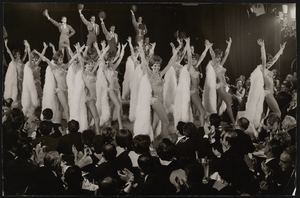
Photographs of the "Bluebell Girls" performing at the Lido, Paris (FRA.), 1950s-1960s
Date
Archival Collection
Description
Image
